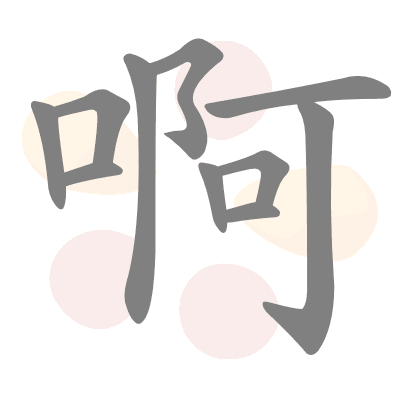啊
啊
par. (used at the end of a sentence) expressing appreciation, agreement, urge, etc.; (used in the middle of a sentence) indicating a pause to draw attention; used when enumerating items
| 80% | 120% |
Register to get less ads.
Registration is free and once you are registered you use this word in your private vocabulary lists.
Then you can train your own vocabulary either here or using one of our applications for PC, iOS or Android.
Registration is free and once you are registered you use this word in your private vocabulary lists.
Then you can train your own vocabulary either here or using one of our applications for PC, iOS or Android.
Other meanings
| interj. oh, wow, huh... (to express agreement, admiration, etc. with a prolonged tone) |
|
| interj. (to press for answer) well; (asking for repetition) eh, what |
|
| interj. ah, aha, what (to express puzzled surprise) |
|
| interj. ah (expressing surprise or admiration) |
|
Simplified Chinese Traditional Chinese |
Simplified stroke orders are based on the 'Standard of National Commonly-used Mandarin Chinese Characters (现代汉语通用字笔顺规范)', issued by the China National Language and Character Working Committee (国家语言文字工作委员会) on April 7th 1997. Traditional stroke orders are based on information issued by the Taiwan Ministry of Education.
一 一 phr. One holiday follows another. It's great! |
他 他 phr. He has gone to the toilet for a long time, why hasn't he come out yet? |
我 我 phr. I have urged you several times. Why haven't you finished the work yet? |
是 是 phr. Yeah.; Yes. (used to show agreement or affirmation) |
多 多 phr. How interesting! |
是 是 phr. It's you. |
好 好 phr. (of taste) So bitter! (of living) So much suffering! So miserable! |








